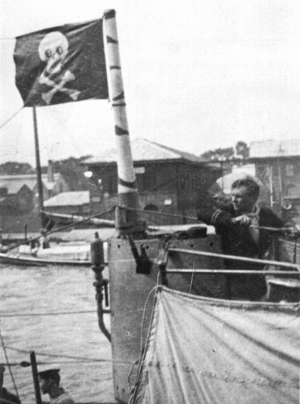HMS H5
HMS H5, was a British H-class submarine of the Royal Navy. She sank the U-boat U 51 in July 1916, but was herself sunk after being rammed by the British merchantman Rutherglen when mistaken for a German U-boat on 2 March 1918. All on board perished; they are commemorated on Panel 29 at Royal Navy Submarine Museum. Also on board as an observer was US Navy Lieutenant Earle Wayne Freed Childs from the American submarine AL-2. He became the first US submariner to lose his life in the First World War. The wreck's site is designated as a controlled site under the Protection of Military Remains Act. A plaque commemorating the 26 who died was dedicated on Armed Forces Day 2010 in Holyhead.[1]
 A view from the bridge of HMS H5. | |
| History | |
|---|---|
| Name: | HMS H5 |
| Builder: | Canadian Vickers, Montreal |
| Launched: | June 1915 |
| Fate: | Sunk, 2 March 1918 |
| General characteristics | |
| Class and type: | H class submarine |
| Displacement: |
|
| Length: | 150 ft 3 in (45.80 m) |
| Beam: | 15 ft 4 in (4.67 m) |
| Propulsion: |
|
| Speed: |
|
| Range: |
|
| Complement: | 22 |
| Armament: |
|
Design
Like all pre-H11 British H-class submarines, H5 had a displacement of 364 tonnes (401 short tons) at the surface and 434 tonnes (478 short tons) while submerged.[2] It had a total length of 171 feet (52 m),[3] a beam length of 15 feet 4 inches (4.67 m), and a draught length of 12 feet (3.7 m).[4] It contained a diesel engines providing a total power of 480 horsepower (360 kW) and two electric motors each providing 320 horsepower (240 kW) power.[4] The use of its electric motors made the submarine travel at 11 knots (20 km/h; 13 mph). It would normally carry 16.4 tonnes (18.1 short tons) of fuel and had a maximum capacity of 18 tonnes (20 short tons).[5]
The submarine had a maximum surface speed of 13 knots (24 km/h; 15 mph) and a submerged speed of 11 knots (20 km/h; 13 mph). British H-class submarines had ranges of 1,600 nautical miles (3,000 km; 1,800 mi).[2] H5 was fitted with a 6 pounds (2.7 kg) Hotchkiss quick-firing gun (6-pounder) and four 18 inches (460 mm) torpedo tubes. Its torpedo tubes were fitted to the bows and the submarine carried eight 18 inches (460 mm) torpedoes.[2] She is a Holland 602 type submarine but was designed to meet Royal Navy specifications. Her complement was twenty-two crew members.[2]
Service record
On 14 July 1916 H5 spotted the U-51 leaving the Ems and torpedoed her. U-51 sank with the loss of 34 of her crew; four men survived.[6]
References
- "Ceremony for Armed Forces Day marks submarine tragedy". BBCNews. BBC. 19 June 2010. Retrieved 1 July 2010.
- "H-class". Battleships-Cruisers, Cranston Fine Arts. Retrieved 20 August 2015.
- Derek Walters (2004). The History of the British 'U' Class Submarine. Casemate Publishers. pp. 2–. ISBN 978-1-84415-131-8.
- Colledge, J. J.; Warlow, Ben (2006) [1969]. Ships of the Royal Navy: The Complete Record of all Fighting Ships of the Royal Navy (Rev. ed.). London: Chatham Publishing. ISBN 978-1-86176-281-8. Retrieved from Naval-History on 20 August 2015.
- J. D. Perkins (1999). "Building History and Technical Details for Canadian CC-Boats and the Original H-CLASS". Electric Boat Company Holland Patent Submarines. Retrieved 20 August 2015.
- National Archives, Kew: HW 7/3, Room 40, History of German Naval Warfare 1914–1918
- MCA website: controlled sites under the Protection of Military Remains Act
- SI 2008/950 Designation under the Protection of Military Remains Act 1986